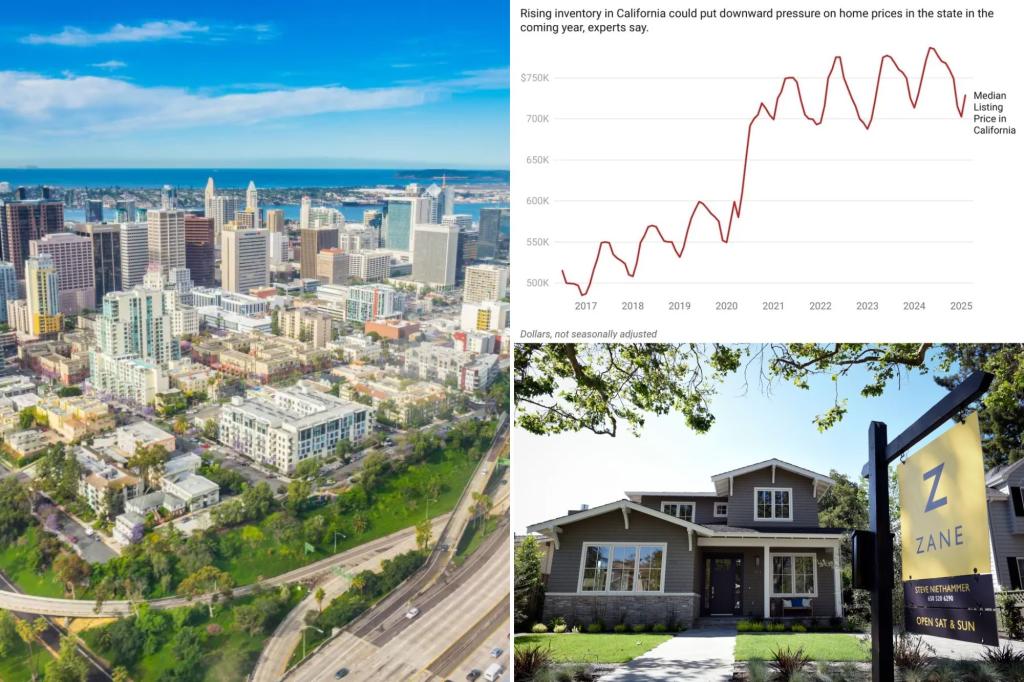The housing market in California is flashing a key warning signal that could lead to a slowdown in home price growth or even falling prices in some markets.
The supply of homes listed for sale in California is surging, rising 44% in February compared with a year ago, according to data from the Realtor.com® economic research team. The national increase was just 28%.
The California surge is the fourth-largest annual increase in active listings among the states, behind only Nevada, Hawaii, and Colorado. In some California cities, the effect is even more pronounced.
Nick Gerli, founder and CEO of real estate data startup Reventure App, noted in a recent post on X that 5 of the top 11 U.S. cities for annual inventory growth are in California, including San Diego, where active listings are up 61% from a year ago.
Rising inventory is usually an early warning sign of weaker price growth, as supply begins to outpace demand, leaving buyers with more options and forcing some sellers to make concessions.
“It’s very realistic to expect that, based on the more than 50% year-over-year inventory increase in some of these California markets, we’re going to see a big slowing in home price growth over the next 12 months,” Gerli tells Realtor.com.
“I wouldn’t be surprised if prices trend flat across the state or even slightly negative by the end of the year, and particularly in certain markets,” he adds.
Some California markets might have also hit an “affordability wall” on home prices, notes Gerli. In San Diego, for example, the median February list price of more than $948,000 is far out of reach for a family making the local median household income of about $104,000.
Still, Gerli says the rising inventory warning comes with an important caveat, which is that California’s housing supply is expanding from a state of severe shortage, and today just 0.6% of the state’s homes are on the market.
Statewide, housing inventory remains well below pre-pandemic levels. Gerli doesn’t anticipate a dramatic price correction in California, but rather a more gradual market reset, supported by low unemployment and mortgage default rates in the state.
“We’re still nowhere near what we’ve seen in Florida in terms of supply,” he says. “I almost view what we’re seeing in California today as maybe what we started seeing in Florida a year ago.”
Hannah Jones, a senior economic research analyst with Realtor.com, says that although many California metros have seen climbing active listings annually, inventory levels remain below pre-pandemic levels in most of them.
“These markets are moving back toward balance, which can be seen in slowing price growth and moderating time on market,” she says. “Some markets have seen listing prices fall annually in recent months, but some of the decline is because of a shift in the mix of inventory available.”
In other words, a rising share of smaller homes listed for sale has dragged typical prices down, a trend that has also been observed nationwide.
However, three California cities did see annual declines in median list prices per square foot in February: San Diego, Sacramento, and San Francisco.
San Francisco saw the sharpest decline of 7.3%, followed by San Diego falling 2% and Sacramento losing 1.3%.
Only time will tell if the lower square-foot list prices in those cities will translate into lower sales prices and falling home values.
“As inventory builds, it is likely that price growth will continue to ease and time on market will slow,” says Jones. “However, California metros tend to be rather competitive and undersupplied, so it is unlikely that prices will adjust lower too significantly in the short term.”
